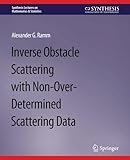Inverse Obstacle Scattering with Non-Over-Determined Scattering Data [electronic resource] / by Alexander G. Ramm.
By: Ramm, Alexander G [author.] .
.
Contributor(s): SpringerLink (Online service) .
.
Material type:  BookSeries: Synthesis Lectures on Mathematics & Statistics: Publisher: Cham : Springer International Publishing : Imprint: Springer, 2019Edition: 1st ed. 2019.Description: XV, 53 p. online resource.Content type: text Media type: computer Carrier type: online resourceISBN: 9783031024184.Subject(s): Mathematics
BookSeries: Synthesis Lectures on Mathematics & Statistics: Publisher: Cham : Springer International Publishing : Imprint: Springer, 2019Edition: 1st ed. 2019.Description: XV, 53 p. online resource.Content type: text Media type: computer Carrier type: online resourceISBN: 9783031024184.Subject(s): MathematicsPreface -- Introduction -- The Direct Scattering Problem -- Inverse Obstacle Scattering -- Bibliography -- Author's Biography.
The inverse obstacle scattering problem consists of finding the unknown surface of a body (obstacle) from the scattering ����(����;����;����), where ����(����;����;����) is the scattering amplitude, ����;���� ���� ����² is the direction of the scattered, incident wave, respectively, ����² is the unit sphere in the ℝ³ and k > 0 is the modulus of the wave vector. The scattering data is called non-over-determined if its dimensionality is the same as the one of the unknown object. By the dimensionality one understands the minimal number of variables of a function describing the data or an object. In an inverse obstacle scattering problem this number is 2, and an example of non-over-determined data is ����(����) := ����(����;����₀;����₀). By sub-index 0 a fixed value of a variable is denoted. It is proved in this book that the data ����(����), known for all ���� in an open subset of ����², determines uniquely the surface ���� and the boundary condition on ����. This condition can be the Dirichlet, or the Neumann, or the impedance type. The above uniqueness theorem is of principal importance because the non-over-determined data are the minimal data determining uniquely the unknown ����. There were no such results in the literature, therefore the need for this book arose. This book contains a self-contained proof of the existence and uniqueness of the scattering solution for rough surfaces.


There are no comments for this item.